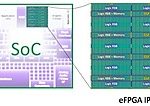This morning, Synopsys announced its new Die-to-Die PHY IP. This announcement is critically important as it addresses two major market drivers – the growing need for faster connectivity in the datacenter and similar markets, and a path to better exploit the latest processes by dealing with yield issues for larger dies in a different… Read More
Tag: synopsys
Functional Safety ARC Processor IP will speed automotive system design
In the automotive space you can’t even get out of the starting gate without Functional Safety (FS). All electronic system that go into cars must have ISO 26262 certification. However, this is not something you slap on after the fact. From the ground up the requirements for ISO 26262 must be considered and the proper processes must… Read More
Synopsys and Infineon prepare for expanding AI use in automotive applications
We all know that cars are using processors for many tasks, but it is easy to fail to comprehend just how many there are in a typical modern car. Browsing through the Infineon AURIX automotive processor application guide, you can start to see just how pervasive processors are. The AURIX processors are specifically designed for automotive… Read More
Webinar – Fabless: The Transformation of the Semiconductor Industry 2019 Update!
As more than 343 people (and counting) know, we will be releasing the 2019 updated PDF version of our first book “Fabless: The Transformation of the Semiconductor Industry” via handout at a live webinar. The response has been overwhelming and I want to personally thank you. The webinar will be a brief overview of the book with a question… Read More
Tortuga Webinar: Ensuring System Level Security Through HW/SW Verification
We all know (I hope) that security is important so we’re willing to invest time and money in this area but there are a couple of problems. First there’s no point in making your design secure if it’s not competitive and making it competitive is hard enough, so the great majority of resource and investment is going to go into that objective.… Read More
eFPGA – What a great idea! But I have no idea how I’d use it!
eFPGA stands for embedded Field Programmable Grid Arrays. An eFPGA is a programmable device like an FPGA but rather than being sold as a completed chip it is licensed as a semiconductor IP block. ASIC designers can license this IP and embed it into their own chips adding the flexibility of programmability at an incremental cost.… Read More
Synopsys and Synaptics Talk About Securing the Connected Home
Like many people, I have been adding automation to my home, and the number of connected devices I use has slowly but steadily increased. These include light bulbs, cameras, switches, a thermostat, a voice assistant, etc. Between them, they know when I am home or away, and have the ability to record images and sound. In addition to … Read More
#56thDAC SerDes, Analog and RISC-V sessions
The good news is that the next five DAC events will take place in Moscone Center in San Francisco! If going to Las Vegas from the Bay area is an easy trip, coming from Europe to Las Vegas makes it a 24+hours journey… One obvious consequence was the poor attendance to the exhibition floor. But let’s be positive and notice that the number… Read More
Semiconductor IP Security Issues
Every morning I read the headlines from SemiWiki, CNN, LinkedIn and my Twitter feed, and it seems like every week that I read about another security breach that makes me wonder if anything online is secure. Companies try to harden their web sites, IT infrastructure and even their electronic products from being exploited or tampered… Read More
The IoT will meet 5G soon, but not with the old SIM cards
By now you have probably realized that 5G is a lot more than an incremental change from previous 3G and 4G cellular technology. For instance, 5G will be used to connect our phones in completely new ways, such as with microcells in urban areas using mm-wavelength signals. 5G will also include two low power protocols that are intended… Read More











